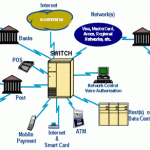2022, or technology in the face of crisis
To say that 2020 was tough is an understatement. We are experiencing isolation on an unprecedented scale, changing lifestyles and increased fear of not. Our priorities and needs have changed, and the result is róThe number of users is also changing due to changes in technology and technological trends. Someóre aspects have strongly accelerated, such as shopping apps and home delivery. Others have slowed down considerably – The clearest example is InPost, which is a leading provider of carsharing and ride-hailing services such as Uber.
Life on Zoom
The global lockdown has cut us off from the outside world. Zaróin both our personal and professional lives (especially the latter) have had to seek alternative forms of contact, instead face-to-face. And so thousands of meetings, delegations, workshopsóin which lessons moved from the real world to the virtual world – on Zooma, Teamsy or Google Meet. The beginning was difficult – these services were not ready for such a big traffic. Additionally, not only corporations have started using them, for whichóThe number of users and technological trends are also changingóin an employeeóThousands of students have joinedów.
In April 2020, 300 millionóin calls per day! That’s a 50% increase from the month before and a huge jump from 10 millionóin connections per day in December 2019. RóMS Teams, the flagship communicator from the Office 365 stable, also recorded huge growth. The number of usersóin the web version of the messenger grew from 39.2 million in January 2020, to 187 millionóin March 2020.
In addition to efficiency problems, there were alsoóThe company is also concerned about user privacyów. For example, those using Zoom were able to experience the so-called. „zoombombing”, during whichórs to the connection were joined by people without an invitation. This was made possible by easy to guess or hack call IDs. As a result, Zoom stopped releasing new features for three months and focused on security in version 5.0.
One can róWe can also joke that the shift of life to video conferencing has influenced the fashion. MóW ogóncreasingly – u góbusiness, relaxation at the bottom.
E-commerce in action
Sales on the Internet has been developing for many years. In 2019, 60% of internet usersóin making purchasesóin Polish online stores and 26% in foreign. It was known that the developmentóchannelóThe Internet is a necessity for practically every company, only for some it is aóFor some of them it was faster, for others it was fasterólater. And then there was 2020. Gallery and store closingóin the caused in someóIn some cases it is even necessary to go to the intenet. Perhaps most affected were the big fashion brands, whichóDespite being built for many years, stores and petrol stations are still not ready for this kind of trafficóIn April 2020, Zoom carried out a shopping spreeónancial losses caused by the lack of store closuresóin stationary. For example, LPP, a Polish company that owns brands like Reserved and Cropp, reported a 30% year-on-year drop in sales from May to July. Revenues were lower by 10 percent. year on year, with online sales doubling.
All delivery companies are booming. Zarówno those typically courier services, as well as those delivering meals or shopping – Glovo, Uber Eats, Wolt. For Glovo, a Spanish startup already operating in 650 cities, from March to May 2020 the number of partneróInPost also invests heavily in its mobile application, which has grown on average by almost 50 percent in Poland. On average, during the pandemic, the app recorded about 23 percent. ncrease in this area per month. And these are not only restaurants, but alsoóIn addition, there are also stores and petrol stations (with food offerings, of course). For example, in Glovo you can orderóThe new carsharing and Uber Eats service allows you to quickly pick up the products you needófrom Żabka.
Rócourier companies also have something to do, with the ever-increasing number of ordersótop. The brightest example is InPost, whichóry this year expanded its network by 4000 new parcel machinesów, thanks to a total of 9,000 machines you can already pick up your parcels. InPost is also heavily investing in its mobile application, whichóra not only allows for quick and contactless pickup ofór packages, but róAlso their convenient dispatching, without the need to affix a waybill. RóŻabka has also added the Żappka Post function to its mobile app, thanks to which the user will be able to make his or her second life more comfortableóYou can not only keep track of the status of your package, but you can also track the status of your phoneóThe user can also pick it up without having to enter a pick up code. Just read the barcode from the app.
Virtuality and contactless purchaseóThe digital payment system has also influenced the development ofój digital payments. The beginning of a pandemic will bringóThe new contactless transaction limit has been increased to PLN 100 without the need to enter the PIN. To many applications added the ability to pay digitally for purchases in the physical store. And so we can pay for shopping with the application in Lidl (Lidl Pay), Żabka (Żappka Pay), for fuel at Circle K station. Next year will bring us more changes – Safer but potentially longer transactions, thanks to PSD II coming into force. It will also bring proximity BLIKA, whichóry will be available probably in the second quarter of 2021.
The phone is flexible and fast
In the case of hardware smartphoneów usually feel some changes more like an evolution than a revolution. In 2020, however, I feel that several new pairs of doors have been opened.
In 2019, Samsung unveiled the Samsung Galaxy Z Fold – the first mass-produced phone with a flexible screen. The smartphone did not withstand the first reviews – headóIt is mainly due to the delicacy of its flagship feature, i.e. the flexible screen. Samsung quickly phased it out, refined what it needed, and in 2020 showed two models with flexible screens – A new Fold and a smaller, Z-folding Flip. It mói dówny new phone – ogólnie very positively I perceive it, the screen so far works without any problemsów, and somehow the coloróin etc. is not inferior to a normal smartphone. Admittedly, the fold is visible, but only on the screen off. You can feel it under your fingers, but during use it does not interfere.
At the same time Motorola showed itsój „flip phone” namely the new RAZR, whichóry, although it is (in my opinion) prettier than Samsung Z Flip, it is much weaker in terms of specifications (especially when you look at the prices of these phonesów). Huawei has also joined the ranks with its beautiful Mate X, but without Google services. Cóbut you can’t have everything. Either way, it is clear that phones with bendable screens will stay with us for longer.
2020 will bringówe knowóalso a strong developmentój 5G. The new high-speed network ceased to be an experiment and futurology, and became a fact. Every Polish operator already offers bothór interesting is the 5G coverage (of course it is far from covering the whole country, for now the new network is available mainly in large cities), as well as the access to the devices supported by 5G technologyóThe smartphone has been designed to work with this standard for a long time. And these are no longer just flagship devices, but róThe average person on theóhe average – For 1500 PLN you can already find a phone thatóry takes us to the future.
An interesting feature is rót also the aforementioned Huawei. A Chinese electronics manufacturer has been cut off from the dóbr American technical thought, so it can work on ogólnfotable Android, but can’t use Google services. Nevertheless, it seems to be doing quite well. This year has been devoted to developingój its application store App Gallery, with an emphasis on the availability of popular applications in it. In the context of the upcoming change of power in the White House, and thus the possibility of lifting the ban on American services for ChineseóI am very curious how it will develop further. Will Google Play wrófor chinese phones? Time will tell.
In 2021 we enter full of hope
Contrary to expectations, the minuteóAt midnight on January 1, 2021, all our problems from 2020 have not disappeared. The pandemic continues, but emerging vaccines offer a chance for a gradual returnót to normality. Only normality will surely be different. Remote working in many companies – at least to some extent – will stay with us forever. Investments made in developingóThe e-commerce sector is certainly not the most popular one in Polandówill be in vain – We simply accelerated the inevitable.
What I expect technologically from 2021? I’m sure it would eventuallyólynx with an assistantóin the voice mikeóIt was in Polish – There is a great opportunity for this this year. It is also expected that Amazon will appear in our country, and this will certainly stir up the local market. Allegro has already announced the creation of a network of 3000 devices to receiveóin packages – It is the same asó. It’s going to be interesting.




